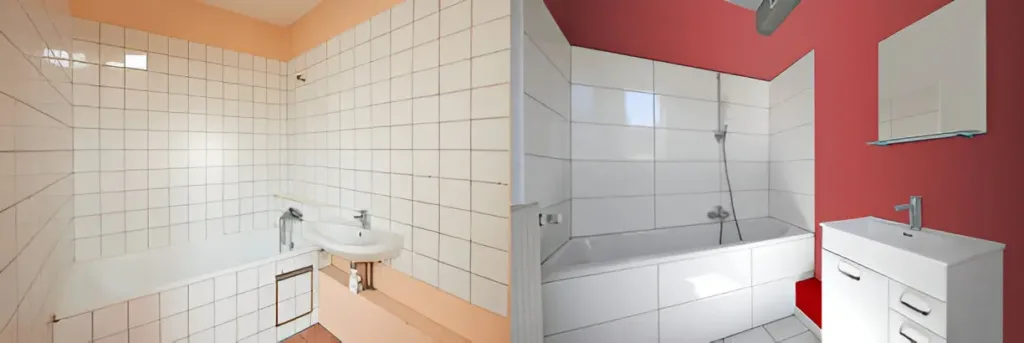Table of Contents
- Introduction
- Benefits of Tub-to-Shower Conversions
- Factors to Consider Before Converting
- Design Ideas for Small Bathrooms
- Safety Features to Include
- Environmental Impact of Shower Conversions
- Cost and Budgeting
- Navigating the Remodeling Process
- Common Mistakes to Avoid
Introduction
Bathrooms should be sanctuaries of comfort, yet many outdated designs must offer the necessary functionality and style. One transformative trend gaining popularity among homeowners is tub to shower conversions. This modern renovation not only enhances the overall aesthetic appeal of your space but also maximizes accessibility, turning your bathroom into a haven of convenience and style tailored to meet the needs of contemporary living.
Converting a bathtub into a shower has broad appeal, meeting the needs of diverse households. It offers seniors a safer environment free of hurdles that traditional tubs pose. Young professionals may find allure in the sleek and modern styles showers bring. Even families can benefit from a layout that integrates better into the fast-paced nature of daily routines. As you explore the possibilities of such a conversion, it’s crucial to consider the multitude of benefits that this renovation could bring to your lifestyle and home value.
Benefits of Tub-to-Shower Conversions
One of the primary advantages of tub-to-shower conversions is increased accessibility, a feature particularly beneficial for those with limited mobility. Walk-in showers eliminate the barrier presented by traditional tubs, providing a safer and more user-friendly environment. Not only do they offer convenience, but they also reduce the risk of slips and falls, effectively making your bathroom a safer space for everyone.
Showers contribute significantly to creating a contemporary and streamlined look. They enhance your bathroom’s visual appeal, creating a modern, uncluttered, elegant atmosphere. Moreover, showers can feel open and accessible when space is premium.
Factors to Consider Before Converting
Before embarking on a tub-to-shower conversion, assessing your bathroom’s existing layout is essential. Consider plumbing locations, existing dimensions, and structural support requirements to ensure a seamless transition. The practicality of the existing space must be weighed against the desired design features to achieve an optimal outcome.
Choosing the suitable materials and fixtures is equally crucial in ensuring durability and ease of maintenance. Modern surfaces such as high-quality tiles and corrosion-resistant fixtures ensure longevity and ease of cleaning, enhancing the user experience. Seeking professional consultation can be invaluable, as experts provide guidance through the complexities of bathroom renovation, helping to address any potential obstacles that may arise during the process.
Design Ideas for Small Bathrooms
Designing for a small bathroom poses unique challenges, but creativity can offset space constraints. Utilizing vertical space by installing shelving or high wall-mounted fixtures keeps the floor area clear and uncluttered. Every inch counts in small areas, and taking advantage of wall surfaces can provide additional storage without sacrificing space.
Clear glass enclosures add modern flair to your bathroom and open up the visual space. They create an illusion of a larger area, making them an excellent choice for enhancing small spaces. Moreover, incorporating creative tile patterns can draw the eye upward or outwards, further strengthening the perception of space and adding a unique charm to your design.
Safety Features to Include
When converting tubs to showers, prioritizing safety should be a key consideration. Opting for non-slip flooring can prevent accidents in wet conditions, creating a secure environment for all users. Installing strategically placed grab bars offers additional stability and peace of mind, especially for older people or children.
Adjustable showerheads can enhance user comfort, accommodating people of different heights and preferences, thereby personalizing the shower experience. These safety measures ensure that the new shower space is visually appealing but also functional and secure.
Environmental Impact of Shower Conversions
An essential consideration in any renovation is its environmental impact. Showers often consume less water than traditional baths, making them a more sustainable choice. Reducing water usage helps lessen the ecological footprint of your bathroom and contributes to conservation efforts.
Choosing eco-friendly materials and fixtures also makes a significant difference. Explore options that minimize waste and make use of sustainable resources. As highlighted by the EPA’s WaterSense program, innovative water-saving technologies can enhance efficiency and sustainability, showing how advanced features can benefit both the environment and your utility bills.
Cost and Budgeting
Understanding your budget is essential to any remodeling project. Determining a realistic range early on helps manage expectations and informs decision-making. It’s critical to be aware of potential overages and keep financier options handy should the need arise.
Procuring quotes from multiple contractors can provide insights into competitive pricing and highlight potential areas for cost-saving measures. Keeping quality intact while exploring less expensive alternatives is a balanced approach to financial planning in renovations.
Navigating the Remodeling Process
Choosing the right contractor plays a pivotal role in the success of your remodel. Look for experienced professionals with positive testimonials and a demonstrated ability to meet deadlines and budgets. A contractor who communicates effectively and understands your vision is vital to managing timelines and aligning their work with your expectations.
Ensure all necessary permits and regulations are adhered to, preventing costly delays or legal issues. Well-managed projects will comply with all zoning regulations and be prepared to pass inspection, making the completion phase seamless.
Common Mistakes to Avoid
Careful planning and attention to detail can easily avoid several common pitfalls. Ensuring thorough inspections before beginning work uncovers any hidden plumbing issues that could cause delays or additional costs later. Proactive measures save time, money, and stress.
Ventilation is frequently overlooked in bathroom renovations, yet it’s crucial for preventing moisture damage and mold growth. Installing adequate ventilation systems can protect your investment and extend the life of your bathroom.
Finally, rushed planning often leads to unnecessary obstacles. Developing a comprehensive plan before breaking ground ensures that your project moves forward smoothly, ultimately leading to a bathroom that exceeds your expectations in functionality and aesthetics.
Also Read-How to Identify Well-Made Fashion Pieces That Stand the Test of Time
